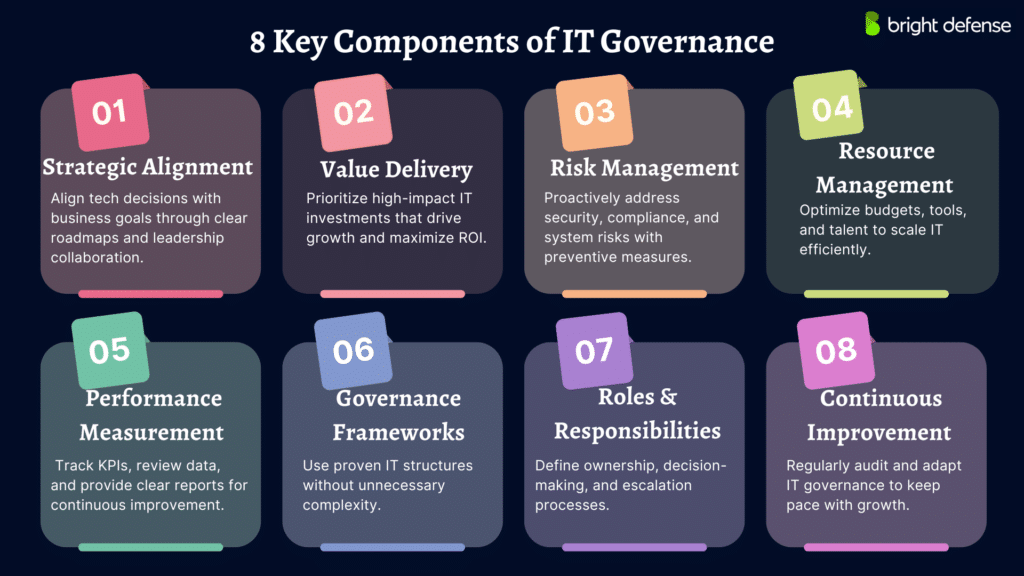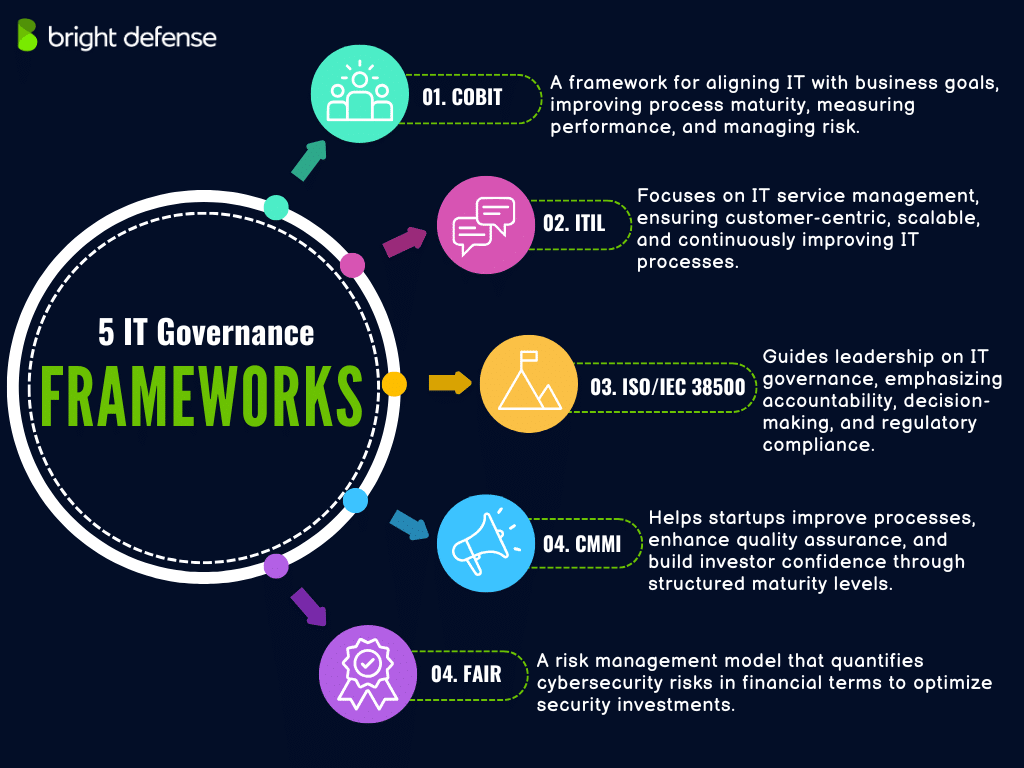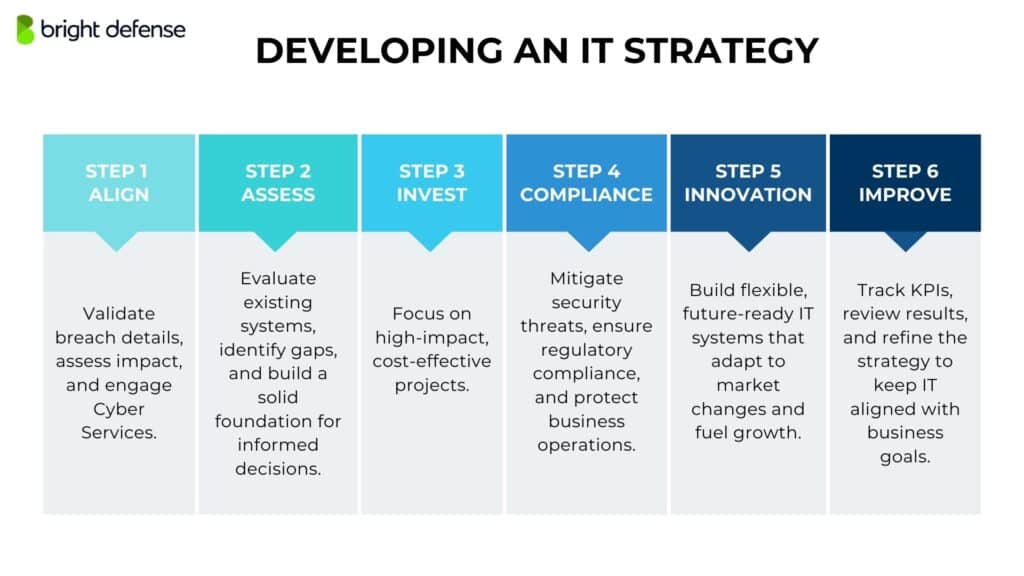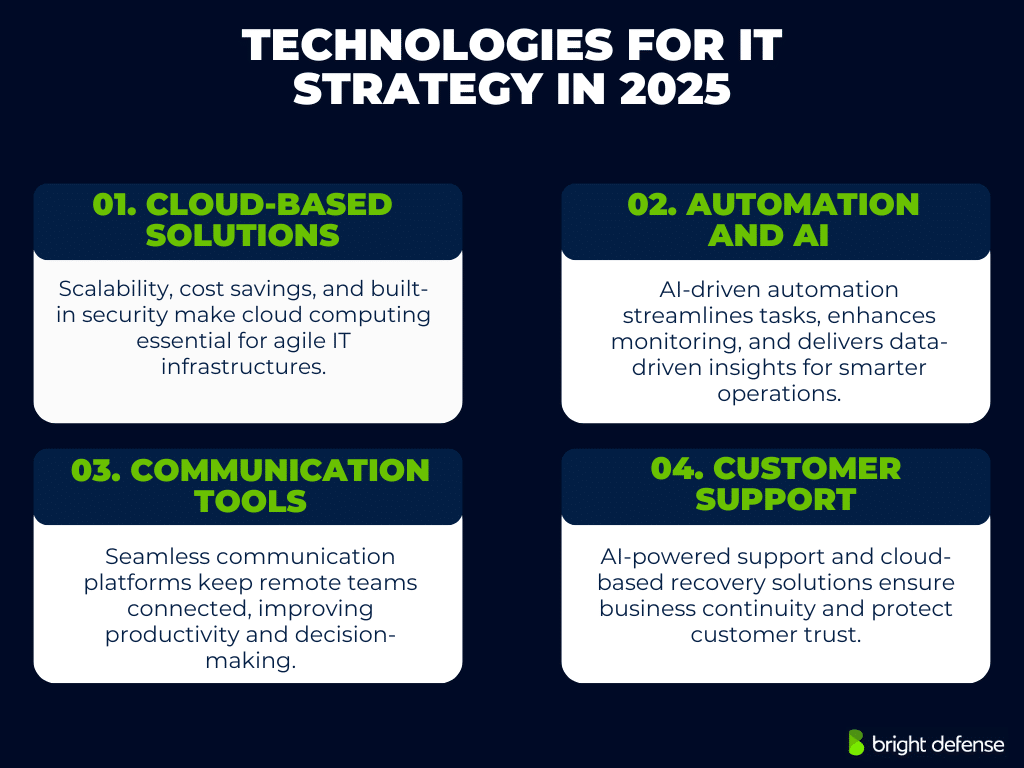
Tamzid Ahmed | Security and Compliance Writer
February 19, 2025
IT Governance and Strategy for Startups: Best Practices for 2025
Startups often prioritize rapid development over structured IT management, leading to costly oversights and security vulnerabilities down the line.
With data generation expected to hit 181 zettabytes in 2025 and cybercrime expected to cost businesses $10.5 trillion annually by 2025, effective data governance has morphed from a “nice-to-have” into a mission-critical priority.
In this blog, we will explore practical, actionable advice for startups, focusing on the often-overlooked but vital areas of IT management.
We will cover the essentials you need to know to make sure your IT supports your startup’s path to success.
Let’s dive right in!
What Is IT Governance?
IT Governance refers to the system by which an organization’s information technology (IT) infrastructure and resources are directed, controlled, and managed to align with and support the organization’s overall strategy and objectives.
It establishes the decision rights, accountability frameworks, and policies needed to ensure that IT investments deliver value and minimize risks.
What Is an IT Strategy for Startups?
An IT strategy is more than just a plan—it’s the game plan for how a startup will use technology to grow, stay competitive, and avoid costly mistakes. While big companies have extensive IT roadmaps, startups need an approach that’s flexible, budget-friendly, and focused on scaling fast.
A good IT strategy answers key questions:
- What tools and platforms will support growth?
- How can tech give the company an edge?
- How can operations stay efficient without breaking the bank?
Key Reasons Why IT Strategy Matters for Startups
- Most startups don’t make it. Around 90% of startups fail, with 70% shutting down between years two and five. One of the biggest reasons? Poor IT decisions that lead to tech bottlenecks, wasted resources, and operational chaos. (Source: Embroker)
- Tech startups face steep challenges. The tech industry has a 63% failure rate, showing how difficult it is to keep up with shifting technology and market demands. Having a solid IT strategy can mean the difference between staying ahead or shutting down.
- Smart decisions backed by data. Startups that use data analytics to track market trends, customer behavior, and operations make better choices, faster. Without the right tools, they risk falling behind competitors who rely on data-driven insights. (Source: BVP)
- Security isn’t optional. Startups handle sensitive data from day one. Ignoring cybersecurity can lead to data breaches, financial losses, and a damaged reputation. A solid IT strategy includes security measures from the start, not as an afterthought.
8 Key Components of IT Governance
IT governance make sure technology drives business growth, minimizes risks, and delivers value. For startups, a solid framework keeps IT aligned with goals, efficient, and cost-effective.
Here are eight key components to get it right.

1. Strategic Alignment
Every tech decision should serve a bigger purpose—whether that’s launching a new product, reaching more customers, or cutting costs. Without alignment, startups risk spending money on tools that don’t move the business forward.
How to stay on track:
- Work closely with business leaders to match IT priorities with company goals (e.g., launching a product vs. expanding to a new market).
- Create a simple IT roadmap that connects major tech projects to measurable results.
- Set up review meetings with leadership to make sure IT efforts stay focused.
2. Value Delivery
Startups can’t afford to throw money at every new tool or software. IT should do more than keep the lights on—it should help the business grow without breaking the budget.
How to make sure IT adds value:
- Use ROI and cost analysis to decide whether a new tool or upgrade is worth it.
- Regularly check if IT projects are delivering results—if something isn’t working, pivot fast.
- Focus on high-impact IT initiatives that directly support growth, rather than getting lost in “nice-to-have” tech.
3. Risk Management
Cyber threats, compliance headaches, and system failures can derail a startup before it even takes off. Risk management is about spotting trouble early and putting safeguards in place.
How to keep risks under control:
- Run regular risk assessments to catch weak spots before they become real problems.
- Set up security measures and backup plans—better safe than scrambling after a breach.
- Build a culture of security awareness so employees know how to handle data and avoid common threats.
4. Resource Management
Startups don’t have unlimited budgets or tech teams. Managing people, tools, and budgets effectively keeps IT from becoming a bottleneck.
How to manage IT resources smartly:
- Allocate IT budgets based on what truly drives growth.
- Keep an updated list of all software, hardware, and licenses to avoid waste.
- Hire, train, or outsource the right skills to handle new tech needs as the company scales.
5. Performance Measurement
If you don’t measure it, you can’t improve it. Tracking IT performance helps startups fix problems before they grow and stay on top of their game.
How to track and improve IT performance:
- Use key performance indicators (KPIs) like system uptime, response times, and project completion rates.
- Regularly review data to find inefficiencies and adjust strategies.
- Give leadership clear reports and dashboards to keep everyone in the loop.
6. Governance Frameworks and Policies
Instead of making IT decisions on the fly, startups can borrow from industry best practices to create structure without slowing things down.
How to keep IT structured without red tape:
- Use proven frameworks like COBIT, ITIL, or ISO/IEC 38500—but keep them simple.
- Avoid unnecessary complexity—stick to what works for the size and industry of your startup.
- Create basic policies for security, vendor selection, and data management to keep IT consistent.
7. Roles and Responsibilities
When IT responsibilities aren’t clear, things get messy. Clear roles prevent confusion and keep projects moving forward.
How to assign IT responsibilities effectively:
- Set up IT governance committees (or at least a decision-making process) for big tech moves.
- Clearly define who owns what—from cybersecurity to system maintenance.
- Create an escalation process so problems get solved fast instead of being passed around.
8. Continuous Improvement and Adaptation
Startups evolve fast, and IT governance needs to keep up. The best approach is to review, adjust, and stay flexible as the company grows.
How to keep IT governance relevant:
- Audit governance practices regularly to see what’s working and what needs adjusting.
- Stay updated on new tech, regulations, and market trends to avoid falling behind.
- Encourage a culture of learning and adaptation so IT governance stays efficient, not bureaucratic.
5 IT Governance Frameworks Startups Should Know
Startups need the right IT governance framework to keep technology focused on business goals, manage risks, and improve efficiency. With limited resources, choosing a structured approach can help avoid costly mistakes and support growth.
Here are some key frameworks that can guide startups in managing IT effectively.

1. COBIT
COBIT (Control Objectives for Information and Related Technologies), developed by ISACA, is a comprehensive framework designed to help organizations align IT processes with broader business objectives. It provides a set of best practices, tools, and models that guide effective governance and management of enterprise IT.
Key Considerations for Startups
- Process Maturity: COBIT breaks down IT operations into specific processes and outlines maturity levels. Startups can use these guidelines to gradually increase their process maturity without overcommitting resources.
- Performance Measurement: By offering detailed metrics and performance indicators, COBIT helps startups quantify how well IT supports business goals.
- Risk and Compliance: COBIT incorporates a strong focus on risk management and regulatory compliance, which is crucial for startups looking to build trust with investors, partners, and customers.
2. ITIL
ITIL (Information Technology Infrastructure Library) is a globally recognized framework for IT service management (ITSM). It focuses on defining best practices for delivering and maintaining IT services that align with business needs.
Key Considerations for Startups
- Customer-Centric Services: ITIL’s core processes (e.g., incident, problem, and change management) emphasize delivering high-quality, consistent IT services—essential for startups aiming to quickly gain customer trust.
- Scalable Processes: ITIL’s modular approach lets startups adopt only the practices they need at each stage of growth, avoiding unnecessary overhead.
- Continuous Improvement: By integrating a “plan-do-check-act” approach, ITIL encourages iterative enhancements, ensuring IT services evolve alongside the startup.
3. ISO/IEC 38500
ISO/IEC 38500 outlines key principles and a framework for IT governance and strategy for startups, focusing on accountability, leadership, and organizational structures. Designed for board members and executive teams, it provides guidance on evaluating, directing, and monitoring IT use within an organization.
Key Considerations for Startups
- Leadership Alignment: The standard emphasizes the importance of board-level and C-suite involvement in IT decision-making, helping startups integrate technology strategy into their overall leadership agenda.
- Accountability and Authority: Clearly defining who is accountable for IT performance and who has the authority to make decisions can help early-stage companies avoid confusion and inefficiencies.
- Regulatory and Ethical Use of IT: ISO/IEC 38500 highlights responsible and ethical IT usage, particularly relevant for startups handling sensitive data or operating in regulated industries.
4. CMMI
CMMI (Capability Maturity Model Integration) is a process improvement framework that helps organizations improve their capabilities in product development, service delivery, and supplier management. Although often associated with larger enterprises, it also provides startups with structured guidelines for maturing their processes over time.
Key Considerations for Startups
- Gradual Process Improvement: CMMI outlines five maturity levels. Startups can start at level 1 or 2, focusing on basic project management and process consistency before advancing.
- Quality Assurance and Predictability: By implementing clear processes and standards, startups can produce more predictable outcomes, which is especially valuable when scaling.
- Investor Confidence: Demonstrating compliance with a recognized maturity model like CMMI can be a signal of operational discipline, appealing to investors or larger enterprise clients.
5. FAIR
FAIR (Factor Analysis of Information Risk) is a risk management framework specifically designed to help organizations quantify and prioritize cybersecurity and operational risks. It uses a model-based approach to estimate the financial impact of various risk scenarios.
Key Considerations for Startups
- Risk Quantification: Unlike qualitative methods, FAIR focuses on expressing risk in monetary terms, helping startups allocate resources where they can have the greatest impact.
- Prioritizing Security Investments: With limited budgets, startups can use FAIR to identify the most critical vulnerabilities, ensuring every security dollar is spent wisely.
- Communication with Stakeholders: Being able to articulate risk in financial terms can improve discussions with boards, investors, and potential partners, demonstrating a mature approach to IT governance.
Developing an Effective IT Strategy for Startups
Creating a strong IT strategy is a must for startups. It’s your roadmap to growth, innovation, and operational efficiency. Here’s a direct approach to aligning your IT with your business objectives:

Step 1 – Align IT Goals with Business Objectives
Every IT decision should align with your startup’s vision. Technology isn’t just support—it’s a driver of growth and competitive advantage. IT governance and strategy for startups ensures that every tech decision contributes to long-term success. A structured approach defines success for both your IT team and the business, keeping everyone focused and making decisions easier.
When teams understand the big picture and work toward shared goals, the company moves forward with purpose, creating new opportunities. Linking IT goals to business objectives from the start builds a strategy that keeps your startup on track, helping you adapt to challenges and seize new opportunities.
Step 2 – Assess Your Current IT Capabilities
Before making big moves, assess your startup’s current IT setup—hardware, software, networks, and team. Know your strengths and weaknesses.
A detailed review shows what works and what slows progress. Filling in the gaps allows better decision-making and smarter investments in technology that support long-term goals. A structured IT Governance and Strategy for Startups approach helps allocate resources effectively.
Step 3 – Prioritize Projects and Investments
Startups have limited time and money, so focus on high-value projects. Every IT initiative should align with business goals, cost-effectiveness, and growth potential.
Rather than spreading resources thin, prioritize projects with immediate benefits and long-term impact. Weigh risks, timelines, and adaptability to keep your strategy flexible.
A smart approach ensures resources go where they matter most—driving efficiency, fostering innovation, and fueling growth.
Step 4 – Incorporate Risk Management and Compliance
In a fast-moving startup environment, proactive risk management is a must. Identify IT risks early—security threats, data breaches, or system failures—and put strong safeguards in place.
Compliance matters just as much. Meeting legal and regulatory requirements builds trust and protects your startup as it scales. It’s not just about avoiding fines—it’s about credibility.
Integrating risk management and compliance into your IT strategy ensures smooth operations, protects resources, and supports long-term growth.
Step 5 – Focus on Scalability and Innovation
Scalability and innovation are essential for a startup’s growth. IT systems should support expansion without creating obstacles. Choosing flexible solutions allows your business to grow without constant overhauls.
Innovation moves businesses forward. Using new technologies improves efficiency, keeps operations running smoothly, and strengthens competitiveness. A strong IT Governance and Strategy for Startups framework ensures that scalability and innovation work together, building a solid foundation for future growth.
Balancing scalability with innovation builds a strong IT foundation that supports both current needs and future expansion.
Step 6 – Establish Metrics and Continuous Improvement
Once an IT strategy is in place, tracking its effectiveness and making adjustments as needed is crucial. Set clear KPIs that show how IT impacts business outcomes. Metrics like system uptime, response times, cost savings, and customer satisfaction help gauge success.
Regular reviews keep the strategy on track. Comparing results with KPIs highlights areas that need improvement. As the business evolves, updating the strategy keeps it aligned with current goals.
This approach keeps IT efforts focused, strengthens operations, and reduces risks. A well-structured strategy supports both immediate needs and long-term growth.
Technologies for IT Strategy in 2025
As technology evolves, startups must adapt by integrating innovative solutions that drive efficiency, enhance collaboration, and protect critical operations.
In 2025, several key technologies are essential to crafting an effective IT strategy:

1. Cloud-Based Solutions
Cloud computing has emerged as a foundational technology for modern IT infrastructures. By leveraging cloud-based solutions, startups can:
- Scale on Demand: Quickly adjust resources to meet fluctuating workloads.
- Reduce Costs: Minimize capital expenditures by paying only for the services used.
- Enhance Security: Benefit from robust security protocols and regular updates provided by leading cloud vendors.
- Boost Agility: Rapidly deploy new applications and services to keep pace with market changes.
This flexibility and efficiency enable startups to innovate faster and maintain competitive advantage.
2. Automation and AI for IT Optimization
Automation and artificial intelligence are revolutionizing IT operations by streamlining repetitive tasks and enabling smarter decision-making:
- Efficiency Gains: Automated processes reduce manual intervention, allowing teams to focus on strategic initiatives.
- Proactive Monitoring: AI-driven tools analyze data in real time to predict and mitigate potential issues before they escalate.
- Data-Driven Insights: Machine learning algorithms process vast amounts of information, offering insights that optimize performance and resource allocation.
- Improved Accuracy: Automation minimizes human error, enhancing the overall reliability of IT systems.
3. Collaboration and Communication Tools
In a world where remote and hybrid work models are increasingly common, effective collaboration and communication are critical:
- Seamless Connectivity: Integrated platforms combine video conferencing, instant messaging, and project management tools, ensuring teams stay connected regardless of location.
- Enhanced Productivity: Streamlined communication reduces misunderstandings and accelerates decision-making.
- Real-Time Collaboration: Tools that support document sharing and collaborative editing empower teams to work together dynamically.
- Scalable Solutions: As startups grow, these tools can easily accommodate expanding teams and evolving project needs.
These technologies foster a culture of transparency and teamwork, vital for sustaining growth in a competitive market.
4. Customer Support and Disaster Recovery
Robust customer support and disaster recovery systems are essential to safeguard business operations and maintain customer trust:
- Responsive Support: Advanced customer support platforms, including AI-powered chatbots and integrated CRM systems, ensure rapid and personalized service.
- Business Continuity: Comprehensive disaster recovery plans, often anchored in cloud-based backups and real-time data replication, minimize downtime and protect critical information.
- Risk Mitigation: Proactive monitoring and automated alerts help identify and address potential issues before they impact customers.
- Compliance and Security: Reliable recovery solutions ensure adherence to regulatory standards and protect sensitive data.
Future Trends in IT Governance and Strategy for Startups
As startups navigate the evolving landscape of IT governance and strategy in 2025, staying ahead of emerging technologies and regulatory changes is crucial for maintaining competitive advantage and operational resilience.
1. Agentic AI
Autonomous AI systems, known as agentic AI, are gaining prominence by making decisions and executing tasks without human intervention. These systems integrate capabilities such as memory, planning, environmental perception, and strict safety protocols.
For startups, incorporating agentic AI into their IT frameworks requires a thoughtful approach to governance—ensuring these autonomous agents operate ethically, safely, and in alignment with overall business strategies.
2. Quantum Computing
Quantum computing represents a transformative leap forward, with the potential to solve complex problems far more efficiently than classical computers. While still in its early stages, advancements in quantum computing could revolutionize various industries, prompting startups to reassess their encryption methods and data security protocols.
Keeping an eye on these advancements is essential, as quantum computing may require updates to IT governance and strategy frameworks to protect sensitive information and maintain compliance with evolving security standards.
3. Generative AI
The rise of generative AI, capable of creating content, designs, and even code, presents a unique blend of opportunity and challenge. On one hand, it can drive significant innovation and efficiency; on the other, it introduces ethical considerations and quality control issues.
Startups must develop clear governance policies to manage the integration of generative AI—ensuring that outputs meet quality standards and align with ethical practices.
4. Cyber Resilience Act (CRA)
The European Union’s Cyber Resilience Act introduces standardized cybersecurity measures for products with digital elements. It requires companies to conduct thorough cyber risk assessments before entering the market, maintain comprehensive data inventories, and report security incidents within 24 hours.
With fines reaching up to €15 million or 2.5% of a company’s worldwide annual turnover for non-compliance, startups operating in or with the EU need to be well-prepared to meet these stringent requirements.
5. Digital Operational Resilience Act (DORA)
Effective from January 17, 2025, DORA sets a regulatory framework aimed at ensuring that financial entities can withstand, respond to, and recover from ICT-related disruptions and threats.
Startups within the EU financial sector must adapt their IT governance strategies to comply with these resilience requirements, thereby safeguarding their operations against emerging cyber threats and disruptions.
6. Cyber Security and Resilience Bill (CS&R)
The UK government’s Cyber Security and Resilience Bill is set to update existing cybersecurity regulations by expanding reporting requirements and enforcing more rigorous measures across various sectors.
For startups in the UK, staying informed about the progress and implications of the CS&R is essential, as it will likely shape the nation’s cybersecurity landscape and impact IT governance practices.
Final Thoughts
IT isn’t just an expense, it’s a strategic tool that helps your startup grow. Clear goals, flexible systems, and proactive security measures lay the groundwork for long-term success.
As your business develops, your IT strategy should keep pace. Regular reviews and adjustments help maintain a setup that supports your needs.
Bright Defense provides IT governance and strategy services designed for startups. We help you build a strong foundation so you can stay focused on growing your business and reaching your goals.
Optimize Your IT Strategy Now!
FAQs
The five key components are strategic alignment, value delivery, risk management, resource management, and performance measurement. These ensure IT investments align with business goals, deliver value, manage risks, optimize resources, and track performance effectively.
IT strategy defines how technology supports business objectives, guiding decisions on infrastructure, investments, and innovation. IT governance ensures accountability, risk management, and alignment between IT and business priorities, helping organizations maximize IT’s value.
Startups should adopt a flexible governance framework focusing on scalability, agility, risk management, and resource efficiency. Lightweight versions of frameworks like COBIT or ITIL can help structure IT operations without restricting growth and innovation.
The five dimensions are strategic alignment, value delivery, risk management, resource management, and performance measurement. These ensure IT investments contribute to business growth, risks are controlled, resources are optimized, and performance is continuously evaluated.
Get In Touch



